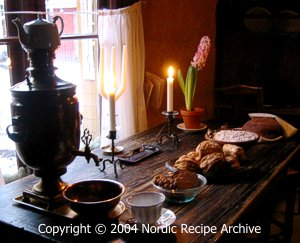The Viking heritage
 In the pre-Christian Nordic countries, it was a custom to celebrate the "return of the light" in time of the winter solstice in December, which marked the beginning of longer days.
In the pre-Christian Nordic countries, it was a custom to celebrate the "return of the light" in time of the winter solstice in December, which marked the beginning of longer days.
Vikings — the Swedes, the Norwegians, the Danes and the Icelanders — celebrated the coming of the sun by sacrificing for their gods, eating and drinking well, playing games, burning bonfires and exchanging gifts during a three-day feast.
The celebrations had many elements that are still common in the modern Nordic Christmas celebration.
 The Swedish, Norwegian and Danish word for Christmas, jul, the Icelandic jól, the Finnish joulu and the Estonian jõul all have their origin in the old Viking word hjul, meaning "sun wheel".
The Swedish, Norwegian and Danish word for Christmas, jul, the Icelandic jól, the Finnish joulu and the Estonian jõul all have their origin in the old Viking word hjul, meaning "sun wheel".
 Nordic countries:
Nordic countries:
1 - Iceland
2 - Norway
3 - Denmark
4 - Sweden
5 - Finland
Areas not visible in the picture: Greenland and
the Svalbard Islands

Finnish kekri
 The Finnish Christmas has its roots in the old pagan harvest feast called kekri, named after the ancient Finnish cattle protector and fertility god.
The Finnish Christmas has its roots in the old pagan harvest feast called kekri, named after the ancient Finnish cattle protector and fertility god.
Kekri was celebrated around the end of November, or the end of the harvest season, marking the end of the year in the old agrarian calendar.
Picture on right: Finnish Christmas dinner table setting from the 21st century
 After Christianity reached Finland in the 12th century, the traditions and habits of kekri began to assimilate with Christian Christmas celebration.
After Christianity reached Finland in the 12th century, the traditions and habits of kekri began to assimilate with Christian Christmas celebration.
These preserved habits include food traditions, such like eating ham from pagan times and lutefisk during fast days from the Roman Catholic time.
Picture on left: Finnish Christmas treats from the 19th century (Helsinki City Museum - Burgher's House)
 The Protestant reformation started by the German monk and theologian Martin Luther (1483 - 1546) also affected Sweden and Finland from ca 1520 on, and the Christmas traditions changed once more.
The Protestant reformation started by the German monk and theologian Martin Luther (1483 - 1546) also affected Sweden and Finland from ca 1520 on, and the Christmas traditions changed once more.
Picture on right: portrait of Martin Luther by Lucas Cranach the Elder (1532), photographed at the National Gallery of Denmark.
Many Catholic religious symbols, like nativity scenes, were banned.
However, nowadays they have become increasingly popular again among the Finnish Lutherans.
